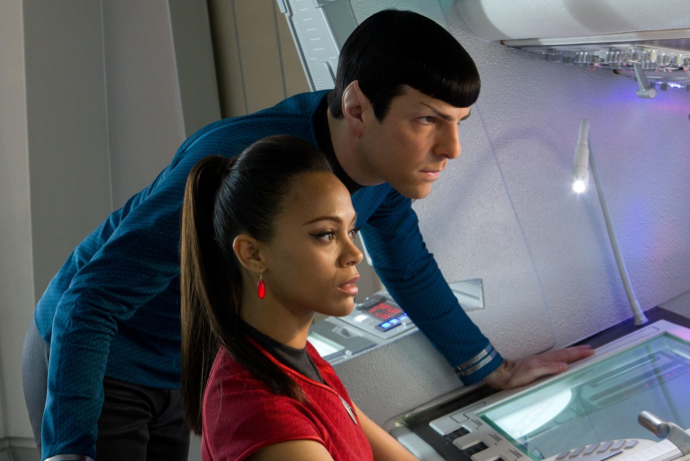Boldly Go? Can Humanity Afford ‘Star Trek’-Like Space Exploration?

The public has no shortage of enthusiasm for fictional spacefarers, as this weekend's box-office win by the newest "Star Trek" film proves. Yet the real-life U.S. space agency finds itself strapped for cash these days. With federal budgets tightening and NASA feeling the pinch, some space advocates are asking, "Can humans afford to reach the stars?"
Believe it or not, experts are looking into the finances of not just relatively short-term missions to Mars and the moon, but also long-term prospects of 'Trek'-ian proportions. It may be possible to find the money, they say, but it would likely take some policy changes — and those changes could start today.
Captain, we don't have the funding!
"Star Trek: Into Darkness" brought in about $84 million in its opening weekend — just a month after NASA cut $200 million from its planetary-sciences budget. (In an odd move, NASA's newest budget explicitly states that it will notfund any missions to Europa, the ice-moon of Jupiter that stands as one of the solar system's best candidates for supporting life, noted Casey Dreier, an advocacy and outreach strategist at The Planetary Society, a nonprofit organization devoted to planetary exploration.) [Warp Drive & Transporters: 'Star Trek' Technology Explained (Infographic)]
Those cuts come as NASA and the rest of the federal government negotiate sequestration cuts, which could trim $7 billion from NASA's ledgers next year if the reductions are maintained.
But even without the sequester, NASA hasn't commanded the kind of money needed for real, ambitious space travel in decades, said Marc Millis, a former NASA propulsion physicist and founder of the Tau Zero Foundation, which is dedicated to interstellar travel.
After hitting an apex with the Apollo moon program, NASA's purse shrunk considerably and has stayed stagnant since, Millis said. NASA's funds reached about 4.5 percent of the total federal budget during the Apollo era, Millis calculated. By 2009, NASA's share had fallen to about 0.5 percent. "The amount that's devoted to NASA now is enough to keep it going," he said. "But to do really cool space travel is not possible now."
Get the Space.com Newsletter
Breaking space news, the latest updates on rocket launches, skywatching events and more!
Essentially, the agency has floated along on autopilot, clutching at relatively low-hanging fruit, like the space-shuttle missions, said Paul Gilster, who researches and writes about interstellar technologies for Tau Zero. "We should have something else than just going 'round and 'round the Earth," he said.
In Gene Roddenberry's original "Star Trek," an international crew voyages aboard the U.S.S. Enterprise, a 938-foot-long (286 meters) starship equipped with transporters, photon torpedoes and other slick tech. (Director J.J. Abrams' new film supersizes the ship to nearly a half-mile long (725 meters). ['Star Trek' Starship Enterpise Evolution in Photos]
Real-world science and engineering feats continue move "Star Trek" technology closer to the realm of science fact: The then-futuristic control panels on the original “Star Trek” television series’ first Enterprise look an awful lot like Apple iPads. And though once ruled out as impossible, recent science suggests the "warp drive," which would permit faster-than-light travel, may eventually be doable.
The "Build the Enterprise" website and petition provide an estimate on a somewhat more reasonable goal than a real starship: a visual facsimile of the Enterprise that could travel around Earth's own solar system, but not other stars. If the spacecraft were built so that it could reach Mars in 90 days, it would cost $1 trillion to construct, estimates the engineer behind the effort, who goes by the moniker BTE-Dan.Possible is one thing; affordable is quite another. According to one calculation, published on Gizmodo.com, the new film's behemoth spaceship would require more than $12 billion in raw materials and $474 billion in weaponry, among other costs — all adding up to a total price tag of roughly $500 billion. By one calculation, funding the oft-repeated "five-year mission" of the original “Star Trek” would cost up to $7.4 trillion, according to Examiner.com.
But this faux Enterprise wouldn't accomplish the real core of the “Star Trek” mythos: human contact with alien worlds around distant stars. To do that, humans will likely need centuries' more technological development — and estimating what that endeavor will cost takes a bit more speculation.
The best place to start is by calculating the biggest-ticket item: energy, Gilster said. Whatever the technology used, it will take an obscene amount of energy to propel a spaceship to the stars. To reach Alpha Centauri, the nearest star beyond Earth's own sun, a spaceship would need to expend 65 terawatts, at a cost of $130 trillion, according to one estimate, Gilster said.
That's a lot of government bonds.
So, how could humanity — let alone the deficit-obsessed U.S. government — ever hope to pay for a real-life "Trek"?
Constructing the Enterprise facsimile alone would require some difficult choices and political will — but the math might work. BTE-Dan estimates that the ship would need $40 billion a year over the course of 20 to 33 years. To get that kind of money, you'd need to shave $2 billion to $10 billion off defense, health, housing, education and other costs every year, while raising taxes.
To pay for the grander mission of true interstellar flight, humanity would not only need new technology, but also vastly more efficient technology and an enormously richer economy. That could actually bring the breathtaking costs of fueling a starship down to a manageable level, Gilster said. "At what point does the amount of power shrink to a small enough percentage of GDP?" he asked. At Tau Zero, experts estimate 3 to 5 percent of GDP to be the sweet spot.
And historical patterns say it's possible, Gilster added. If you take humanity's track record of increased energy efficiency, thanks to better technology over time, and pair that with the historical pattern of a growing, global economy, projections say humanity could economically fuel a starship in 200 to 300 years. It's highly speculative, of course, but "all you can do is look at the historical trends and hope for the best," Gilster said.
From here to there
But to get the energy needed to transport humans to the stars, the planet first needs to build up a lot of infrastructure, Gilster said. That means work must be done in the next few years and over the next few hundred years.

To efficiently produce the energy for an interstellar space program, for instance, the denizens of Earth will likely have to construct a solar energy station in space — on Mercury, for example, Gilster said. That would finally take full advantage of the thermonuclear furnace at the center of Earth's solar system, he said.
But to get there, and to prepare for the long haul of interstellar travel, humans have to develop a greater presence in space and the ability to move around the solar system more easily and frequently, Gilster said. Sending people to Mars and beyond will train scientists in equipping astronauts for long periods in space and open up access to the resources of the solar system, he said.
Just as the Apollo missions had to start with lower-ambition missions in lunar orbit in order to get the technology right for future moon landings, star travel requires more and better solar system adventures. Projects like BTE-Dan's Enterprise, then, could actually serve as necessary first steps toward a real starship. [Video: Warp Drives and Worm Holes]
Motivation
But with planetary exploration no longer a top priority, the way to the stars still looks blocked at the budget line. Funding for those near-term treks into the solar system has to come from somewhere, and the government may not be able to provide it.
However, deep-pocketed adventurers may be able to fill in the gaps. In recent years, private companies, such as Space Exploration Technologies Corp. (SpaceX) and Virgin Galactic, have entered the space race. Those interested in long-term spacefaring hope these companies can make suborbital and Earth-orbit travel cheap enough to actually make it profitable.
"I think that will grow more and more interest, and people will see more ways to make money in space," Millis said.
After that, companies can look into mining asteroids, space tourism and even planetary colonies. If these endeavors become moneymakers, then building the infrastructure for space-based energy production and frequent solar-system travel may pay for itself. With space-based power generation, the profits would multiply by orders of magnitude, Gilster said.That could change the economics of interstellar travel — and one day vastly change the chances funding the planet's boldest missions yet.
Follow us @Spacedotcom, Facebook and Google+. Original article on SPACE.com.
Join our Space Forums to keep talking space on the latest missions, night sky and more! And if you have a news tip, correction or comment, let us know at: community@space.com.

Michael Dhar is a manuscript editor at the American Medical Association and a freelance science and medical writer and editor, having written for Live Science, Space.com, Earth.com, The Fix, Scientific American, and others. Michael received a master's degree in Bioinformatics from NYU's Polytechnic School of Engineering, and also has a master's in English and Comparative Literature from Columbia University School of New York, and a bachelor's in English with a biology minor from the University of Iowa.









